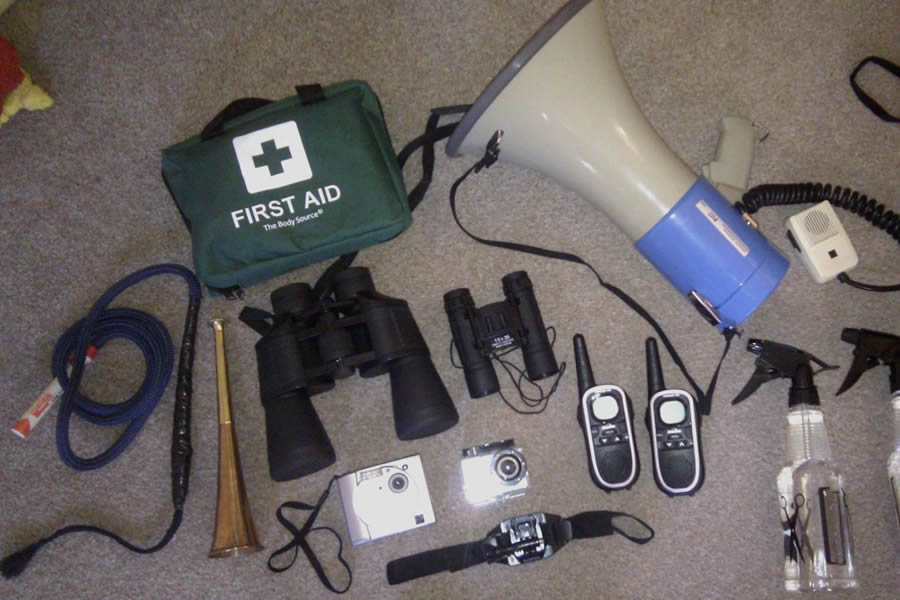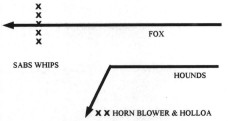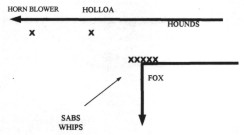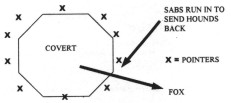
Basic Tools and Equipment
Making and Using a Whip
The use of whips is very much neglected. We use the horn and holloas in the same way as the huntsman, so why not the whip? The whip is used to control the hounds if they are rioting after an animal they shouldn't be, or to stop the hounds from going onto main roads, railways etc. The hounds will stop at the whip because they have been trained to be scared of it. So all the huntsman or whipper-in has to do is to crack the whip and the hounds will stop dead. If you see a huntsman crack the whip near a hound you will see it cower in fear. We can use this to our advantage by stopping hounds when they are in full cry.
The whip is an essential piece of sabbing hardware and is very easy to make.
 For the handle all you need is a piece of dowelling
from a hardware shop. This should be about 2/3 cm thick, and as short
as possible so that it will fit easily into your pocket. The best
rope to use is climbing rope (or similar). The rope for each whip
should be about 1.5 metres long - the general rule is to hold out
your arm and let the rope hang to the floor - that is the length
you want.
For the handle all you need is a piece of dowelling
from a hardware shop. This should be about 2/3 cm thick, and as short
as possible so that it will fit easily into your pocket. The best
rope to use is climbing rope (or similar). The rope for each whip
should be about 1.5 metres long - the general rule is to hold out
your arm and let the rope hang to the floor - that is the length
you want.
Tape about 8 cm of the rope around the dowelling using strong tape. To fasten the rope to the dowelling, the best thing is a plastic clip (from electrical or gardening shops) which, once fastened, can't be undone.
 The cracking noise is made by adding a shoe lace, this only needs to
be about 20 cm long. Tie this onto the end of the rope and put some tape
around it. You will be able to make it more secure by practicing with
different ways. Put a knot near the end of the lace, this helps it to
crack.
The cracking noise is made by adding a shoe lace, this only needs to
be about 20 cm long. Tie this onto the end of the rope and put some tape
around it. You will be able to make it more secure by practicing with
different ways. Put a knot near the end of the lace, this helps it to
crack.
To crack the whip, lift the stick until the shoelace is just off the ground. Flick the stick upwards and then downwards very fast so that the stick follows down the line of the ascending rope. It may take a while but keep trying, you will be able to do it with practice.
Using the Whip in the Field
 The most obvious place to make use of the whip is when hounds are in
cry. Stand on the line where the quarry has just gone. A few sabs should
then start to crack their whips when the hounds come near. They must
also "rate" them (tell them off) so that they think they are doing the
wrong thing. A horn blower should stand at right angles to the line of
the quarry. The horn blower should have holloaed first, then started
to blow fast notes to encourage the hounds to come to them. In theory
the hounds will come to the horn blower and the sabs with the whips should
then move away from the line of the quarry so the huntsman doesn't know
where the quarry has gone.
The most obvious place to make use of the whip is when hounds are in
cry. Stand on the line where the quarry has just gone. A few sabs should
then start to crack their whips when the hounds come near. They must
also "rate" them (tell them off) so that they think they are doing the
wrong thing. A horn blower should stand at right angles to the line of
the quarry. The horn blower should have holloaed first, then started
to blow fast notes to encourage the hounds to come to them. In theory
the hounds will come to the horn blower and the sabs with the whips should
then move away from the line of the quarry so the huntsman doesn't know
where the quarry has gone.
 A good time to use the whip is when the quarry has changed direction
and the sabs run to where the quarry has gone to stop the hounds following
the line. The horn blower should be encouraging the hounds to hunt
on as shown.
A good time to use the whip is when the quarry has changed direction
and the sabs run to where the quarry has gone to stop the hounds following
the line. The horn blower should be encouraging the hounds to hunt
on as shown.
The whip can also be employed when a quarry comes out of a covert. Sabs run in towards the covert and rate the hounds back with voice and horn calls.
Equipment
There follows a list of the various pieces of equipment that have proven useful in the sabotage of hunts, and an indication of where to get the more obscure items. It is by no means necessary to take all of them every time you go out, but some of them are essential.
Binoculars - These can be very useful for spotting the hunt or its supporters from a distance.
Camera/video camera - Cameras and video camera's are invaluable for photographing and recording incidents of hunt cruelty or violence, supporters' car number plates, hunt staff, etc.
CB 's/Walky-talkies - can be extremely useful, allowing sabs out in the field to keep in touch with vehicles.
Change - To buy things with.
Compass - For use with maps, and to ascertain wind direction.
Dictaphone - These can be used for recording conversations with the police on those occasions when they attempt to overstep their powers.
Gizmo - A 'gizmo' is the name sabs use for a small speaker audio player, which plays the sounds of hounds in cry and calls them away from a fox and to the sabs.
Hunting Horn - These are essential. They can be obtained from the local group or the HSA, or can often be found in antique or junk shops. Cotswold horns are the most effective, and can be used on all types of hunting.
Map - Ordnance Survey Landranger Maps (1:50,000) are essential, showing most coverts, footpaths, roads, etc. Pathfinder (1:25,000) show more detail but cover a smaller area. Some road maps contain a useful town index.
Mobile phone -To keep in contact with other sabs.
Notebook & Pen - For recording car number plates, map grid references, police numbers, and information useful for a hit report on the course of the day's hunting and sabotage.
Sandwiches - A variety of sandwiches can prove invaluable during the course of a day's sabbing.
Spray - Scent dulling liquid (Citronella) can be bought online, health shops or chemists. Alternatively you can make up a strong smelling spray of your own using garlic cloves. The best liquid to use a combination of citronella or eucalyptus oil, in water. Small garden hand sprays can be used to spray the liquid when out sabbing.
Whistle - These are very useful if you can't blow a horn. They will often make hounds look up, thus preventing them for searching for scent.
Wire, chain, bike lock and padlock- These can be used for tying up gates to slow down the huntsman.
Whip - See top of this page

